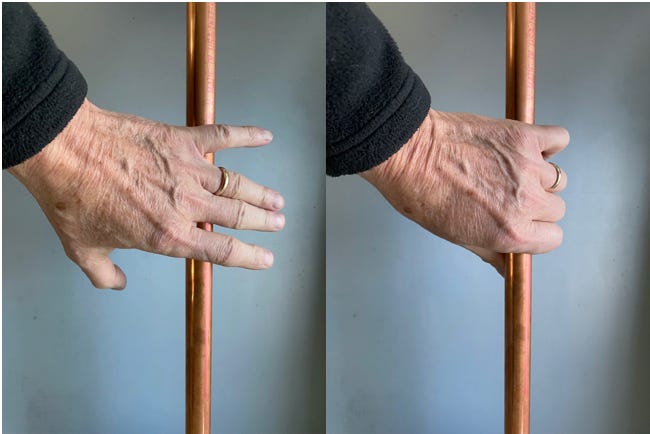Touching metal objects safely!
Anything from a chain link fence to a metal ladder to a pedestal box can have a dangerous contact voltage. Here’s a simple tip to help keep you safe…
Note that the following article is NOT about checking potentially live wiring for voltage with your hand. You need to do a proper meter test to confirm that. This is about staying safe around everyday metal objects such as a chain link fence, pedestal box or even the door handle of an RV that you would never expect to be energized.
Safety First…
Always use your knuckle or a single finger to first touch anything metal that could possibly be energized. Don’t use the palm of your hand, and here’s why…
Your hand has more muscles to make a fist than to open your fingers…
You can try this yourself. Your hand is designed to grab onto things with a lot of strength, not open up with great force. Sort of like the jaws of an alligator that can be held shut with electrical tape.
Don’t do this!
If you touch an electrified object with an open palm, all the muscles in your hand will contract. Since you have more muscles closing your hand than opening it, you’ll grab onto the electrified object and won’t be able to let go…
I’ve had this happen to me a few times, and it’s terrifying. Luckily for me the first time it happened there was someone nearby to turn off the power. The second time I was able to use my body weight to pull myself free. But once the fault current flowing through you reaches 20 mA or so, all the muscles in your body will contract and you just can’t let go. And if you can’t get free quickly enough, your heart may go into fibrillation and you could die by electrocution.
I had a contractor friend nearly die when he grabbed into metal scaffolding that had an extension cord wrapped around a rail. The insulation on the extension cord was worn and the entire scaffold was energized with 120 volts. A nearby worker kicked him free, but it could have been deadly.
Do this first!
Always check every metal object anywhere near electricity with your knuckle or a single finger first. If it’s electrified your hand will tend to jump away and disconnect you from the energized object, possibly saving your life…
Now, I don’t advocate using this technique to replace a voltmeter or Non-Contact Voltage Tester to check for a live circuit, but I tend to do this on door handles, metal boxes, chain link fences, scaffolding, microphones, and anything else that’s near AC power. And this tip has saved my bacon a few times when my hand jumped back and disconnected me from the electrified object. I don’t ever want to experience not being able to let go of an electrified object again.
Let’s stay safe out there… Mike







All submariners know that DC Voltage is much more deadly.